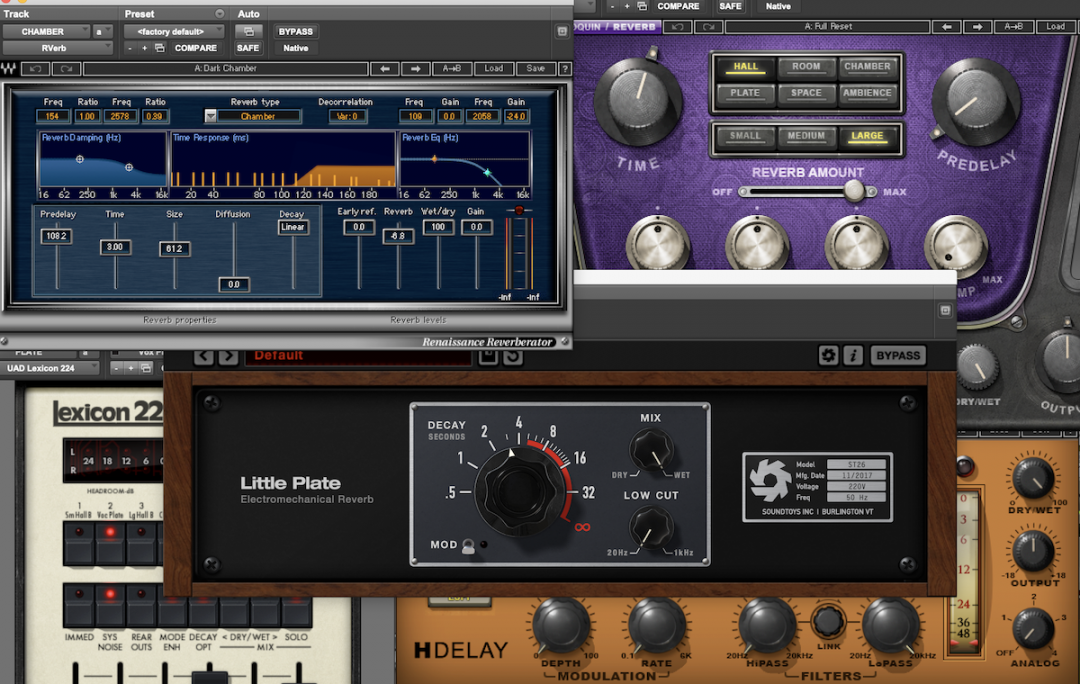Vocals are the centerpiece to any song and generally require a bit more attention than basic rhythm tracks. Since the human voice is the most expressive instrument, you can have a lot of fun mixing them. There’s lots of pretty simple, yet creative reverb and delay tricks you can employ to make your vocal mixes more lush, expansive, and radio-ready.
Use reverse reverb as a transition
Reverse reverb takes the reverb tail of any instrument and reverses it. It’s usually accompanied by the original, unreversed recording playing back as well. Reverse reverb is a really great way to signal a build-up into a big chorus, for example.
You could take the first phrase of the chorus, put reverse reverb on it, and have it fade in as the verse ends and the hook starts. In Pro Tools you can create reverse reverb like this:
- Make a new track and duplicate the audio you want to put reverse reverb on.
- Using AudioSuite, reverse the duplicated audio.
- Now open up your favorite reverb plugin in AudioSuite, and adjust it to taste. Really long decays work well for this trick. Print it.
- Next, reverse the track in AudioSuite one more time.
- Edit and place the clip so that it fades in as the verse is ending and the chorus comes in!
Automate really long reverb tails
This has been a pretty popular technique over the past few years, especially in pop music. Producers and mixers will automate a reverb send to ramp up on certain words or at the end of phrases. The result is a lush, washy sound that envelopes a vocal and takes it to another dimension in the mix. It’s a really awesome sounding trick and doubles as a great transition like reverse reverb mentioned above.
To apply this, you can send your vocal to a reverb and then automate the send level on words you want to saturate with reverb. Arm yourself with your reverb of choice and make sure the decay is long enough to create an other-worldly effect.
“Throw” delay
Reverb and delay are so versatile, and how you use both can seriously up your mixing game. Throw delay is another one of those techniques that’s super popular in rap, pop, and R&B.
Setting up the routing the same way you did for automating reverb tails, you can choose to add delay on certain words at the end of phrases. I like to have a bit of low-level 1/4 delay on my vocals throughout a track — to create a throw, I’d automate the send level louder on a specific word/phrase.
Some engineers manually create throws without using a delay plugin at all. It’s a bit more involved, but you have more control over what the repeats themselves actually sound like. What you do is duplicate or create a new audio track and then copy/paste words or phrases from the lead vocal that you want repeated onto it.
You’ll then want to make sure they’re placed in time at the intervals you want. From here, it’s probably a good idea to mix them at the ideal level — maybe band-pass them so they sound totally different from the leads and aren’t as in-your-face. Since they’re on a new track, you can get as creative with how the throws sound as you want!
Try using two different mono reverbs
Using two different reverbs, you can create two mono auxiliary tracks and pan one to the left and the other to the right. Set one as a plate and the other as a large room with shorter time; it really creates width on the sides!
It’s very common to see mixers using 3 or more reverbs on a vocal and blending them all together nicely. Sometimes these are even regular stereo reverbs, but the point is not to be shy about using multiple spaces to get the sound you want. And if they’re mono, you get a really cool width that you wouldn’t otherwise using a stereo reverb.
Send heavily effected vocals to reverb and delay returns
The idea here is to use something other than dry leads to send to your reverb or delay. You can try something like an octave down. Make a duplicate of the vocals you want, pitch them down, and use that track to send to a reverb or delay.
This helps us take reverb and delay and treat it in an entirely new way, with the goal of opening our minds to create more space. If you can create more space between the reverb and the dry signal it will help the dry lead vocal stand out further in front.
You can mess up the signal going into your reverb any way you want; distortion, flanger, pitch, or all of the above! Try it, it’s a lot of fun.
